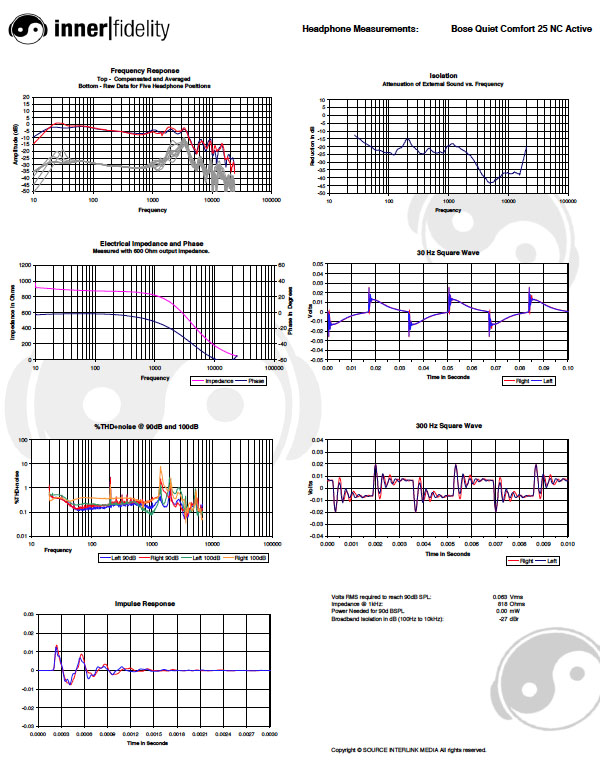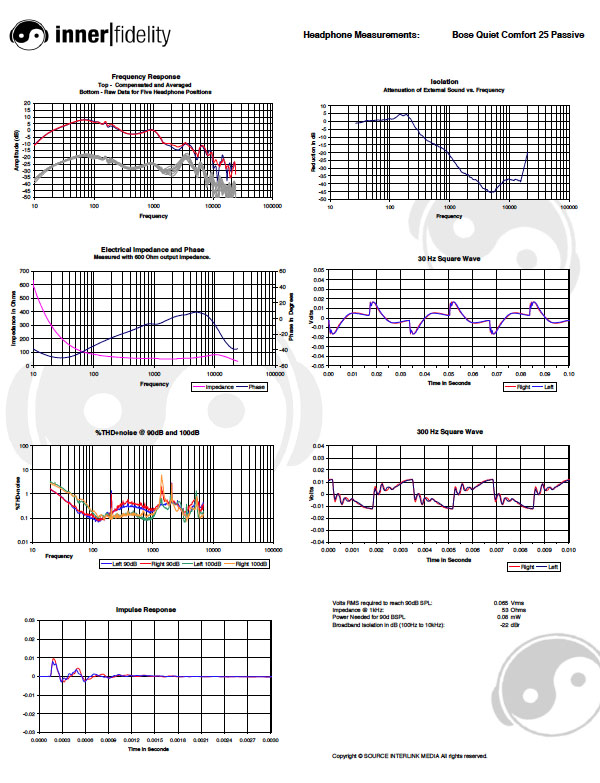| Columns Retired Columns & Blogs |
A Better Traveler's Sanctuary: The Bose Quiet Comfort 25 Measurements
Measurements


Click on graphs image to download .pdf for closer inspection.
Raw frequency respons plots for the QC25 show very stable bass response with positional changes, but oddly some significant differences in the region between 1kHz and 3kHz. I'm not sure what to make of this exactly, but note the rise in distortion in the same area. I suspect that the noise canceling circuits are reaching the frequencies at which noise canceling becomes difficult and various anomolies begin to appear.
Compensated FR plot shows a mild warm tilt, and very good overall linearity to 3kHz. Very few passive headphones are able to remain linear in the 800Hz to 3kHz region, and to my ears I felt the tonal balance was very good as a result. Above 3kHz it's a bit of a bumpy ride down hill, but this falling response above 3kHz is similar to that of the Harman response curve and should probably be considered close to neutral.
30Hz square wave has reasonable good shape compared to most headphones, but compared to many noise canceling headphones it's simply extraordinary. Most noise cancelers make an unholy mess out of 30Hz square waves; that the QC25 looks almost normal is a very pleasant surprise. Between the slight rise in the bass, good 30Hz square wave shape, and relatively low distortion in the bass, you'd think these cans do a lovely job delivering punch down low...and they do indeed.
300Hz square wave has some visually disturbing ringing, but I've come to think this 3kHz ring is strongly related to the first resonant mode between the driver and eardrum, and is less troublesome in listening than one might surmise from the 300Hz square wave. Many headphones exhibit this (Senn HD 600, Focal Spirit Pro, Skullcandy Aviator) and in my experience the result is a slight 'lithpyness' to the sound. The QC25 has this feature a bit more prominently than the other headphones mentioned, and it does seem they have that 'th' instead of 's' character a bit more strongly than those other cans as well. Fortunately, this type of error doesn't create any grating harshness or edginess, and as a result tends to be relatively benign. This is also seen strongly in the impulse response, but other than this feature the impulse response is fairly clean.
As mentioned before, THD+noise shows a significant rise in distortion between 1.5kHz and 3.5kHz, probably leading to my conclusion that this headphone is good mid-fi and does not have the finesse of true high-end headphones...and frankly, I doubt we'll see that in noise cancelers for a long time to come.
Impedance and phase response are somewhat irrelevant as we're looking at the input to an electronic circuit rather than a headphone driver.
Isolation shows excellent noise reduction across the board with -26dBspl attenuation broad band.
With 72mVrms needed to achieve 90dBspl at the ear, this headphone will play to solid listening levels with portable devices.
Click on graphs image to download .pdf for closer inspection.
I'll not analyze these measurements fully, but will point out a few things:
Frequency response is significantly uneven showing just how much DSP correction is being done to the headphones when in active mode.
Impedance and phase response measurements indicate to me that capacitive coupling remains in place when in passive mode.
- Log in or register to post comments





































